Analyzing competitive plays with Bounty Hunter, by Peppo_o'Paccio
Peppo_oPaccio
June 18, 2014
Pros and Cons
Pros
- Very mobile
- His item build is pretty flexible
- One of the strongest off-laners
- Difficult to shut down in the laning phase
- Costantly gives money to the whole team
- Can farm in a solo lane thanks to Jinada
- Can be played in mid lane if the situation calls for it
|
|
Cons
- Not very durable
- No stuns or AoE skills
- Low mana pool in the early game
- Easy kill for hard carries in teamfights
- Too much reliant on his invisibility in the early game
|
When to pick him
 Bounty Hunter is one of those Heroes that works in almost any situations, provided your team doesn't have too many melees and invisible Heroes: he can play amazingly well with little farm and still dominate the mid game, but he has to plan his ganks and work with teammates.
Bounty Hunter is one of those Heroes that works in almost any situations, provided your team doesn't have too many melees and invisible Heroes: he can play amazingly well with little farm and still dominate the mid game, but he has to plan his ganks and work with teammates.
Summarizing, pick
 Bounty Hunter
Bounty Hunter if:
- Your team already has a
 Mekansm carrier and a hard support(s);
Mekansm carrier and a hard support(s);
- You are familiar with invisible Heroes and know when the enemies can detect you;
- Your team needs the gold advantage and mid game dominance;
- Your team needs a solo laner, either against a trilane or a solo lane;
- Your team is planning to push down the other side lane tower, so you can play the mid game outside of your lane.
Also, don't pick
 Bounty Hunter
Bounty Hunter if:
- You can't take the solo or mid lane for any reason;
- Your team needs either a support or an initiator;
- Your team already has 3 or more melee Heroes;
- You forget to spam your
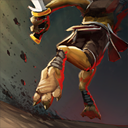 Track;
Track;
- You forget to costantly check the inventory of your enemies, so you get spotted by
 Gem of True Sight,
Gem of True Sight,  Sentry Wards and so on.
Sentry Wards and so on.
Items Explanation: Off-Lane Tournament Build
In tournaments you will always see  Bounty Hunter played as a solo Hero, either against a trilane (or dual lane plus jungler) or another solo: in both cases you will still be able to get experience and, possibly, last-hits; especially if the enemy that's farming is melee.
Bounty Hunter played as a solo Hero, either against a trilane (or dual lane plus jungler) or another solo: in both cases you will still be able to get experience and, possibly, last-hits; especially if the enemy that's farming is melee.
If you are facing a trilane and die, don't give up: you can teleport to your tower and still get experience and money. Also, if you realize they have  Sentry Wards just stay in the experience range (1200 units, as much as the range of a
Sentry Wards just stay in the experience range (1200 units, as much as the range of a  Blink Dagger) and play safe. That gold is not indispensable for you anyway.
Blink Dagger) and play safe. That gold is not indispensable for you anyway.
This build is suited for any kind of people, from beginners to competitive players.
Starting items
Early game items
Situational
Core items
Situational

|
|
You can choose to either pick this instead of the  Drum of Endurance (asking for one of your teammates to buy it, maybe) or after it when running an armor-reducing strategy: the mana regeneration is very helpful in the laning phase and the Valor ability is good in all stages of the game, even (especially?) when fighting Roshan. Drum of Endurance (asking for one of your teammates to buy it, maybe) or after it when running an armor-reducing strategy: the mana regeneration is very helpful in the laning phase and the Valor ability is good in all stages of the game, even (especially?) when fighting Roshan.
|
Core extensions

|
|
A very common "core" item in pub games but often overlooked in tournaments: the sustainability offered by both  Ring of Basilius and Ring of Basilius and  Ring of Regen is nice, and you might need the lifesteal while chasing nukers. Ring of Regen is nice, and you might need the lifesteal while chasing nukers.
The main reason to get this item is, though, for fighting Roshan: especially if you have a melee carry, buying an "early"  Vladmir's Offering can be fundamental to kill him just by yourselves (which means the other 3 Heroes in your team can protect you or push the lanes), and the aura is always helpful in teamfights. Vladmir's Offering can be fundamental to kill him just by yourselves (which means the other 3 Heroes in your team can protect you or push the lanes), and the aura is always helpful in teamfights.
If you want to keep snowballing, though, you'd better aim for something else: the aura doesn't stack with  Assault Cuirass, which is a common pick on some melee-carries ( Assault Cuirass, which is a common pick on some melee-carries ( Lifestealer, Lifestealer,  Alchemist, Doom Bringer...), and it costs as much as a Alchemist, Doom Bringer...), and it costs as much as a  Yasha. So think about this item and don't rush it after your BKB, but don't even forget about the lifesteal aura which can help if your team already has solid DPS and teamfight presence. Yasha. So think about this item and don't rush it after your BKB, but don't even forget about the lifesteal aura which can help if your team already has solid DPS and teamfight presence.
|
Offensive Late Game Items
Defensive Late Game Items
Items Explanation: Orchid Rush
This item build is a valid option since  Bounty Hunter needs costant mana regeneration: the silence plus damage is very helpful too, as this Hero excels in 1vs1 fights. You can try to rush an
Bounty Hunter needs costant mana regeneration: the silence plus damage is very helpful too, as this Hero excels in 1vs1 fights. You can try to rush an  Orchid Malevolence against a solo laner or in mid lane, but trying to farm that much gold in a 1vs3 offlane is just a waste of time.
Orchid Malevolence against a solo laner or in mid lane, but trying to farm that much gold in a 1vs3 offlane is just a waste of time.
This build is still a viable options to everyone, but requires you to coordinate your skills and avoid common juke paths before engaging (all of this come with experience). Therefore, I still consider this for beginners to competitive players though the previous build is preferred in tournaments.
Starting items
Choice 1
Choice 2
Early game items
Situational

|
|
The mana regeneration might seem redundant, but you can still choose to pick this before your  Orchid Malevolence when running an armor-reducing strategy: it gives you a little advantage in the laning phase (the enemy will deal less physical damage on you and you'll be able to do better last-hits using it on the creeps) and the Valor ability is good in all stages of the game, even (especially?) when fighting Roshan. Orchid Malevolence when running an armor-reducing strategy: it gives you a little advantage in the laning phase (the enemy will deal less physical damage on you and you'll be able to do better last-hits using it on the creeps) and the Valor ability is good in all stages of the game, even (especially?) when fighting Roshan.
|
Core items
Situational
Core extensions

|
|
A very common "core" item in pub games but often overlooked in tournaments: the sustainability offered by both  Ring of Basilius and Ring of Basilius and  Ring of Regen is nice, and you might need the lifesteal while chasing nukers. Ring of Regen is nice, and you might need the lifesteal while chasing nukers.
The main reason to get this item is, though, for fighting Roshan: especially if you have a melee carry, buying an "early"  Vladmir's Offering can be fundamental to kill him just by yourselves (which means the other 3 Heroes in your team can protect you or push the lanes), and the aura is always helpful in teamfights. Vladmir's Offering can be fundamental to kill him just by yourselves (which means the other 3 Heroes in your team can protect you or push the lanes), and the aura is always helpful in teamfights.
If you want to keep snowballing, though, you'd better aim for something else: the aura doesn't stack with  Assault Cuirass, which is a common pick on some melee-carries ( Assault Cuirass, which is a common pick on some melee-carries ( Lifestealer, Lifestealer,  Alchemist, Doom Bringer...), and it costs as much as a Alchemist, Doom Bringer...), and it costs as much as a  Yasha. So think about this item and don't rush it after your BKB, but don't even forget about the lifesteal aura which can help if your team already has solid DPS and teamfight presence. Yasha. So think about this item and don't rush it after your BKB, but don't even forget about the lifesteal aura which can help if your team already has solid DPS and teamfight presence.
|
Offensive Late Game Items
Defensive Late Game Items
Items to Avoid
Sometimes, you might have played a pub with someone that buys a  Shadow Blade because they're used to buying it on
Shadow Blade because they're used to buying it on  Sniper or, worse, rushes a
Sniper or, worse, rushes a  Battle Fury. Why is this not recommended? what's wrong with these items?
Battle Fury. Why is this not recommended? what's wrong with these items?
Battle Fury

This is by far one of the most common items from unexperienced
 Bounty Hunter
Bounty Hunter players: they pick this item because it's recommended by the in-game item section. In my opinion, it's the worst recommendation between all the Heroes (well, let's say
 Lone Druid
Lone Druid's item recommendations are as bad as BH's), but Valve isn't probably going to change this.
Do you know why this is a bad choice? Let's compare this with two other common items: a
 Yasha
Yasha (which is one of the most common extensions but costs a lot less) and a
 Desolator
Desolator (which costs about as much as a BF).

Price:
4350
Damage increase:
+65
Attack speed increase:
-
Extras:
+150% mana regen
Cleave damage
|
|

Price:
2050
Damage increase:
+16
Attack speed increase:
(15 + 16) = +31
Extras:
+10% movement speed
+2.24 armor
|
|

Price:
4100
Damage increase:
+60
Attack speed increase:
-
Extras:
-6 armor for any enemy
or structure you hit
|
Now, divide them by their price and you find their benefits per gold (which means cost-efficiency): here I also multiplied them by 1000 so you can see integer (or almost) numbers, easier to understand. These are their benefits if they all cost 1000 gold:

~15 damage
It also gives mana
and HP regen and
the cleave ability. |
|

~7.8 damage
(~7.3 + ~7.8) = ~15.1 attack speed
It also gives extra
attack speed and more
armor. |
|

~14.6 damage
~1.5 armor reduction
per hit
-
|
As you can see, the
 Battle Fury
Battle Fury looks like a great item for its price, right? Well, no. For sure it gives you more damage than the other two, but you
don't need the mana regeneration as you should have either a
 Bottle
Bottle and a
 Magic Wand
Magic Wand or an
 Orchid Malevolence
Orchid Malevolence.
What about the cleave damage, then? It's a nice addition, true, but it doesn't make a big impact in the mid game as you should be ganking
lone enemies and not groups of nukers. On the other side, it doesn't help in the late game either because your hard carry should be farmed enough to deal with those Heroes you can't kill by yourself. You don't even need it to farm as your mid-game is foused on ganking and roaming, not killing creep camps in the jungle.
The
 Yasha
Yasha gives little damage for its price, but remember that Agility means damage, attack speed and even armor! It's a very efficient item in terms of gold and it even makes you faster so you'll have an easier mid game.
Also, remember that you can build it into a
 Manta Style
Manta Style and you can aquire it in half the time compared to the other two.
In the end, the
 Desolator
Desolator gives you (almost) as much raw damage as the Battle Fury but it's better for two reasons: the "accessibility" of this item (it costs 250 gold less and you can aquire the items without going to the secret shop) and, more importantly, the
armor reduction.
By reducing armor, your attack damage will be greatly improved: if you have to choose between -6 armor per hit or +150% mana regeneration and cleave damage, always go for the armor reduction! It does help in teamfights and works for your team's carry, too. It even works against towers.
Radiance

Fortunately I've never seen a
 Bounty Hunter
Bounty Hunter picking this item, but if you are a new player and might want to try it here there are a few things that should change your mind.
The
 Radiance
Radiance is a
farming item and, since you're a ganker and not a farming Hero, you should
never want these kind of items (I've said the same thing about the
 Battle Fury
Battle Fury: in fact, these are actually the best items for killing creeps quickly).
Secondly, getting raw damage for such a high price isn't a good choice on Heroes with low survivability: you will spend ~20-25 minutes trying to get something that doesn't help in any way unless you get within melee range. The same rules applies to the
 Desolator
Desolator but, as it is more accessible and it shouldn't be rushed (as opposed to the
 Radiance
Radiance), this is still considered nice if you have some spare gold after getting survivability items.
Last but most important,
the Burn Damage will reveal you! This is the main reason why you don't want this: as soon as your enemies start burning, they will begin to pop
 Dust of Appearance
Dust of Appearance or plant
 Sentry Ward
Sentry Wards. You can toggle the aura on and off, true, but that would make this item inefficient for its price and removes its best feature.
Shadow Blade

The
 Shadow Blade
Shadow Blade gives you 10 damage and 10 attack speed for each 1000 gold spent on it, which is still way better than a
 Sange and Yasha
Sange and Yasha, but doesn't give any other benefits besides the invisibility. Items like a
 Skull Basher
Skull Basher or an
 Orchid Malevolence
Orchid Malevolence have better abilities or more features, thus you'd better aim for them.
What about the invisibility? There are three main reasons why the
 Shadow Blade
Shadow Blade is used: split pushing, escaping and cleave amplification/surprise ganks.
First,
 Bounty Hunter
Bounty Hunter can't split push because he has no AoE spells and can't clear a creep wave in a small amount of time.
You don't need the invisibility for escaping either, as you already have
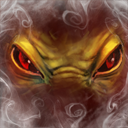 Shadow Walk
Shadow Walk and enemies would have already bought invisiblity-detection items for you by the time you get it.
Cleave amplification? You already have your
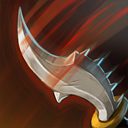 Jinada
Jinada which amplifies your
 Shadow Walk
Shadow Walk damage. Surprise ganks? The invisibility from your
 Shadow Walk
Shadow Walk is enough, you might add a silence from the
 Orchid Malevolence
Orchid Malevolence if you feel you need more safety.
Also, if you buy it for the movement speed increase while you're invisible you would waste gold: you already have
 Phase Boots
Phase Boots, a
 Drum of Endurance
Drum of Endurance and maybe even a
 Yasha
Yasha.
Skill Build
 Bounty Hunter uses a rather standard skill build which grants both solo laning advantage and big mid game presence: your main priority is
Bounty Hunter uses a rather standard skill build which grants both solo laning advantage and big mid game presence: your main priority is 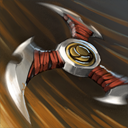 Shuriken Toss, but you need
Shuriken Toss, but you need  Shadow Walk and
Shadow Walk and  Jinada to farm better and have a safer laning phase. Laning-wise, getting the second level of
Jinada to farm better and have a safer laning phase. Laning-wise, getting the second level of  Shadow Walk is really important because that way you can basically be invisible forever, as long as you have mana.
Shadow Walk is really important because that way you can basically be invisible forever, as long as you have mana.
 Shuriken Toss
Shuriken Toss is your one and only nuke, so you always max it out first: the damage scales pretty well especially at level 1-2, and you will always need it to snipe enemies low on health. The main problem is its mana cost: that's why you max it out at level 8 instead of 7.
 Jinada
Jinada is your main skill for farming and your most important ability for ganking: the cooldown reduction is amazing and the crit multiplyer scales with levels, too! You need an early points in it for last-hitting with safety, then you can max it out right after Shuriken Toss so you can abuse the crit and maim.
 Shadow Walk
Shadow Walk is taken at level 1 for having a safe early game and a bit more last-hitting power: since getting a second level is mana-efficient (25% extra duration for the same mana cost) and you can stay permanently invisible with it, you need a second point in the laning stage. The bonus damage kind of scales with Jinada, so you want to max it out before this ability.
 Track
Track is obviously your ultimate and the main reason why you can easily make up for the lack of gold in the mid game: get this skill whenever possible and use it as soon as you spot an enemy. With levels, this skill gains many improvements including a wider cast range, more bonus gold for both yourself and your allies, a smaller mana cost and a cooldown reduction.
Playing Style
As said many times, this Hero excels in solo lanes (especially in the off-lane): you want to focus on both surviving and farming efficiently, prioritizing one of them depending on the situation and laning.
This chapter will be divided in the following paragraphs to let you understand better:
Suicide Laning (1vs3)
This laning style is probably the most common situation for
 Bounty Hunter
Bounty Hunter, as you can get all the experience from the creeps and the enemies won't even notice you: don't try to buy an Orchid Malevolence, but focus on the first skill build (
 Phase Boots
Phase Boots and
 Drum of Endurance
Drum of Endurance, for example, can let you dominate the mid game).
Remember that you're not invincible while
 Shadow Walk
Shadow Walking: always check the inventory of the enemies and, if you think they placed some wards, just stay in the exp range.
The most important thing about suicide laning that pub players don't understand is that you
should not focus on last-hitting! If there are three enemies ready to gank you, it isn't a wise choice at all.
In this lane, the most important thing you have to do is to get experience. So, don't focus on the enemies and don't waste your mana (or worse, don't get in melee range with them) for harassing: most of the time you will die or be forced to go back to base.
Remember that positioning is crucial: in suicide lanes don't go past the enemy trees (on your right if in
top lane for
Radiant, on your left if in
bot lane for
Dire) unless you want to disrupt the enemy creep pull. Even so, keep your distances and make sure they don't have any
 Sentry Ward
Sentry Wards nearby.
Summarizing, always remember the following things:
- Always check the inventory of your enemies! You don't want them to spot you with
 Sentry Wards.
Sentry Wards.
- Don't get last-hits at all, if not with
 Jinada.
Jinada.
- Don't harass the enemies, or they will most likely kill you before you can even react.
- Most important thing: don't overextend! Unless you go to disrupt the enemy creep pull, don't go past those places where the enemies can come from behind.
Solo Laning (1vs1)
This is another common situation: as a mid game Hero, you benefit a lot from the farm and you can make good use of it buying cost-efficient items (
 Drum of Endurance
Drum of Endurance) or expensive objects that give you mid game dominance (
 Orchid Malevolence
Orchid Malevolence).
Try to get as many last-hits as possible but don't let the enemy harass you, especially if they're ranged: you can sometimes use
 Shadow Walk
Shadow Walk in conjunction with
 Jinada
Jinada for harassing if you have something to sustain your mana and if you can last-hit without the crit damage from your ability.
Be active in the mid game! Always carry a
 Town Portal Scroll
Town Portal Scroll with you and be ready to teleport to other lanes if needed to. Generically, you shouldn't be afraid to leave your lane as a lone Hero can't push down a tower.
As soon as you reach level 6 and you get
 Phase Boots
Phase Boots-
 Drum of Endurance
Drum of Endurance or
 Orchid Malevolence
Orchid Malevolence, you can start ganking. As always, make sure the enemies don't have
 Sentry Ward
Sentry Wards,
 Dust of Appearance
Dust of Appearance or a
 Gem of True Sight
Gem of True Sight.
This quick list can help you remember all the paragraph:
- Last-hit as much as possible and trade hits with the enemy laner if they try to harass you.
- Always keep a TP scroll in your inventory and go to other lanes if you see a ganking opportunity.
- After getting
 Track and your main items, start roaming and kill/outlane as many enemies as possible.
Track and your main items, start roaming and kill/outlane as many enemies as possible.
Mid Laning
Rarely, you can play
 Bounty Hunter
Bounty Hunter in mid lane: provessional players tend to avoid this because it's very difficult to find a solo laner as good as you, but if your team is going for an offensive trilane and your mid laner would have been, let's say,
 Lone Druid
Lone Druid or
 Nature's Prophet
Nature's Prophet, you'd better give the 1vs1 safe lane to them.
In this lane the
 Orchid Malevolence
Orchid Malevolence build is almost always mandatory, as you will be able to leave mid and go to gank without worrying about your tower: especially against a melee Hero, you'll find very easy to get last-hits and pick up runes before the enemy.
The only difference in the item build is that you should rush the
 Bottle
Bottle first, maybe start with the common 3
 Iron Branch
Iron Branches +
 Tango
Tango set and get your items sooner.
Ganking
Ganking:
 Bounty Hunter
Bounty Hunter excels in this, but you have to be very careful and position yourself so that you won't miss the kill or, worse, die. Remember to reach level 6 and get your
 Phase Boots
Phase Boots-
 Drum of Endurance
Drum of Endurance or
 Orchid Malevolence
Orchid Malevolence before trying to get kills, unless you find lone and weakened enemies.
If you're off-laning and you reach level 6,
don't leave your lane unless you know the enemy supports are roaming or a tower is already down: even in this case try to be as quick as possible and don't let the enemy carry free farm, if possible.
As said before, positioning is key: try to get a good
 Jinada
Jinada hit and, after
 Track
Tracking the enemy, push them to your side of the map; you can do so by returning visible between them and their towers/ancient, maybe with a teammate ready to help.
Always try to get lone enemies, as you're not good in 1vs2 fights. Also, remember that casters can succesfully escape from you (unless you got an
 Orchid Malevolence
Orchid Malevolence) and even kill you if their teammates are nearby.
Even when ganking, remember to check the enemies' inventory: if you're sure they got a
 Gem of True Sight
Gem of True Sight try to spot who has it and focus them in the next teamfight. Otherwise, if you see
 Sentry Ward
Sentry Wards and
 Dust of Appearance
Dust of Appearance on their inventory you can still get the kill and run away, provided they are alone.
In some words, these are your main priorities while ganking:
- Reach level 6 and get your mid-game items before ganking.
- Even if you're level 6 and got your items, don't leave the lane unless your/their T1 tower is already down.
- When ganking a lone enemy, try to put yourself between them and their base so that they will have a hard time trying to escape.
- Always look for lone enemies and stay away from casters, unless you can silence them or a teammate can help you.
- Check the inventory of your prey: if they have a gem, focus them on the next teamfight.
Teamfighting
I've already said many times that
 Bounty Hunter
Bounty Hunter is a perfect off-laner and even a good ganker, but even though
 Track
Track doesn't reduces the enemy armor anymore he can succesfully "turn" an odd fight to your advantage: even if a fight ends with 2 kills from both sides,
your ultimate will still grant a gold advantage.
When starting a teamfight, be useful: use your
 Shadow Walk
Shadow Walk (unless they can see you) to scout for hidden initiators,
 Track
Track the most important enemies, be ready to activate your Drums/Orchid and so on. Try to keep your APM (
Actions Per Minute) high so that you will be ready to engage.
As the teamfight starts, select the target you want to focus: Gem-carriers, initiators, blinkers and squishies; always help in chasing and pop your BKB (if you have one) as soon as you reach melee-range. Remember that you can use
 Track
Track defensively, too: if you lose a teamfight, by tracking an enemy chaser you and your teammates will move faster.
Your autoattacks are pretty hard to deal with, but remember that you're not durable at all: even so, assist your team's carry and don't be afraid to come to close range even though your BKB isn't ready or your Orchid is on cooldown; you still have a lot of movement speed (with
 Phase Boots
Phase Boots, particularly) and your
 Track
Track if things go wrong. Also, if you die your carry might still escape, which is a good thing.
Friends and Foes
The bright side about this Hero is that he works with almost anyone, so you can safely pick him if you need a solo laner; on the other hand, invisibilty detection and stuns can be really hard to deal with in the mid game.
Friends
When you end your laning phase, try to
 Track
Track lone enemies and gank them with your allies: a
 Smoke of Deceit
Smoke of Deceit can be really useful for this, especially because you won't get revealed if you are
 Shadow Walk
Shadow Walking. In this case, try to pair with allies that can disable or silence for a good amount of time (first line is for usual mid laners, second line is for lane supports and junglers):
Foes
As said before, Heroes that can reveal
 Bounty Hunter
Bounty Hunter are a solid counterpick to him; silences are a good counter too but in mid to late game BH relies mostly on autoattacks, thus making them less useful. The first line is for dispellable (you can purge them with
 Diffusal Blade
Diffusal Blade or the active ability of
 Manta Style
Manta Style) or temporary abilities, the second line is for skills and items that will always work on you:
A special mention goes to
 Rubick
Rubick: if he manages to steal your
 Track
Track not only he will be able reveal you, but will grant extra gold for his team and nullify your gold advantage.
Update History
05-20-2014: Added slight changes.
01-23-2014: Reworked this guide for the 6.79 patch (better late than never!).
03-22-2013: Added the "Items to Avoid" chapter.
03-13-2013: Added the "Playing Style" chapter.
03-12-2013: Added an explanation for situational items.
03-10-2013: Wrote the first part of the guide.
 Poor Man's Shield
Poor Man's Shield
















































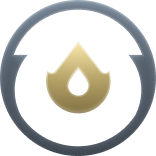

























Quick Comment (27) View Comments
You need to log in before commenting.